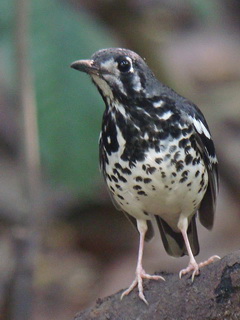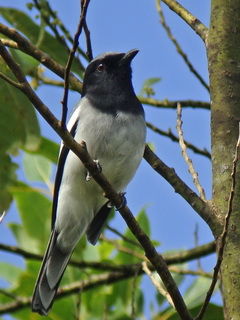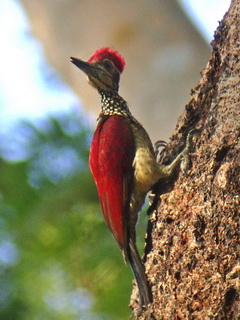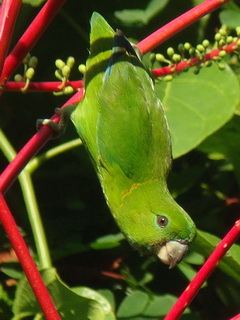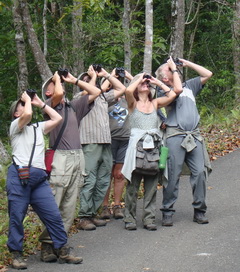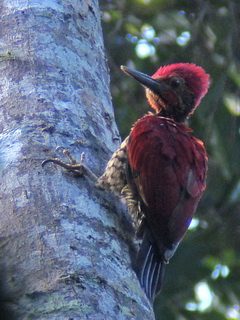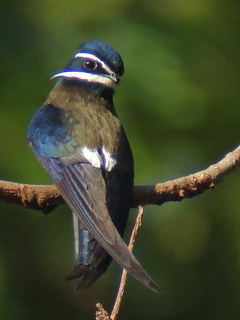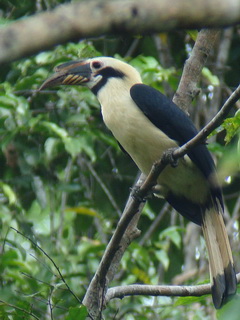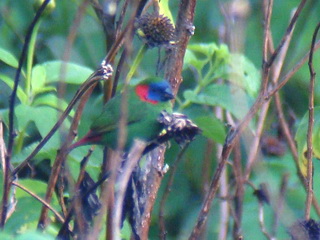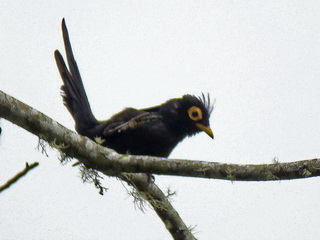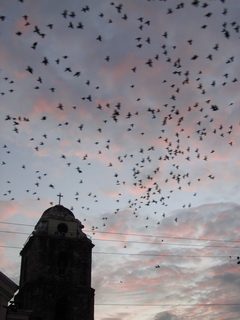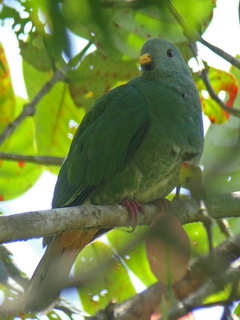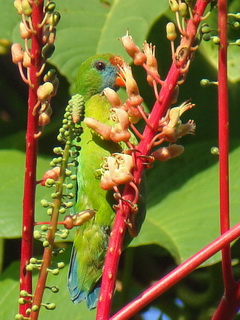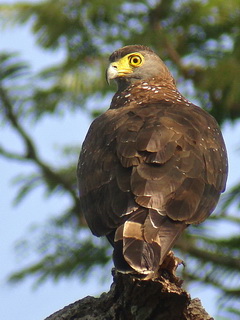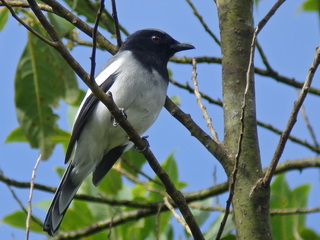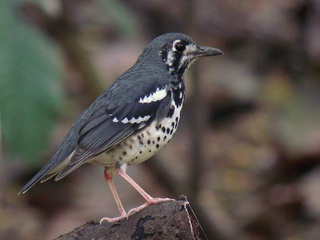B2A Philippines 2014 tour
report.
Luzon, Bohol, Cebu and Mindanao, 9-22 February
Participants; Jan
van de Leur, Helena Relou, Sylvie Péloquin,
John and Tess Spalding, Philippe Blain. Tour leader; Stijn
De Win
Candaba Marsh, Subic Bay, Mt. Makiling, Rajah Sikatuna NP,
Alcoy Nug-as Forest, Mt. Kitanglad
(+Palawan extension + Davao & Mindoro 5th anniversary
trip)
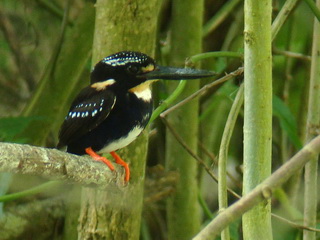
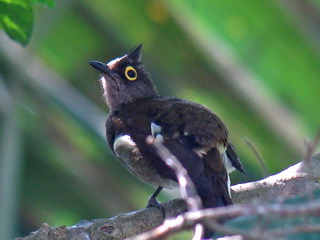
Silvery Kingfisher, BoholYellow-wattled Bulbul, Mt. Makiling
Smooth and sweet and dry, that’s how this tour went. For a start, to meet for our main tour with a group of very nice and certainly smiling participants was a delight. No wonder though as they’d just come from what I was told a successful and pleasant Palawan pre-tour with Falcated Ground Babbler, Palawan Peacock Pheasant, Philippine Cockatoo and indeed all the other wished for endemics seen well. With such a head-start and happy group members it was easy to continue; straight on to Ashy Thrush first thing in the morning, then Philippine Duck at Candaba marsh en-route before enjoying a good first set of Philippine endemics in the forests of Subic bay. The Philippine Eagle Owl performed well at it’s stake-out together with a surprise Scale-feathered Malkoha before we went for some relaxed and good birding at Los Banos and Mt. Makiling.
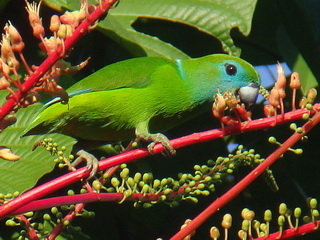
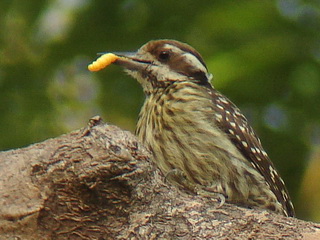
Guaiabero, Subic BayPhilippine Woodpecker, Subic Bay
With everything organized meticulously our travel and logistics went as smooth as possible and Bohol went over in a breeze… time goes fast indeed on an enjoyable tour. Silvery Kingfisher in the bag though! And so the OceanJet brought us to Cebu without delay for some relatively easy birding and certainly a pleasant walk at Alcoy forest. In good tradition we saw the endangered Black Shama within minutes and just meters from our van perched in plain view for ages, while a Black-chinned Fruit Dove was ever so reluctant to take off. A little later we found ourselves on Kitanglad where after some big surprise Chestnut-cheeked Starlings on the way up we got treated with the most productive late afternoon/evening session possible. Fifteen lifers in a couple hours kind of, big flock, Frogmouth, Woodcock… great job by all. The Philippine Eagle didn’t let us down with no less than 3 sightings and other highlights were excellent views of Red-eared Parrotfinch, White-cheeked Bullfinch, McGregor’s Cuckooshrike, Apo Sunbird and Giant Scops Owl. Three of us continued on to Davao and Mindoro which was a free trip on occasion of Birding2asia.com’s 5th anniversary; We celebrated indeed which was easy enough with Philippine Eagle on the nest, Mindoro endemics...but that’s another story you may read if you click here.
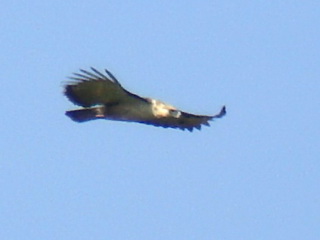
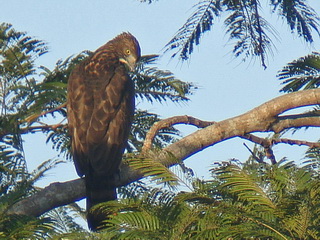
Philippine Eagle, Mount KitangladLuzon Hawk Eagle, Subic
Best of all, this tour went without a single drop of rain!!! Something I personally find super important to fully enjoy the birding in the Philippines is good weather. Prolonged rain on a tour can be such a misery at times; birds that don’t come out of hiding, lost birding time, no photo opportunities… let alone damp clothing, birding gear getting soaked or muddy and slippery trails. Talking about the weather I just copied and paste following line from our tour report that I wrote last year; “Anyway, no worry at all, for next year, what we did is make a new reservation for some repeated luck indeed.” And so it happened, this year, our tour went without any rain!!! I find it hard to believe after all the reports of endless rain and storms in December and January although those seem to become more common in the first months of the Philippine birding tour season . If you’re interested in birding and the Philippine climate please proceed to our boxed text at the bottom of this page.
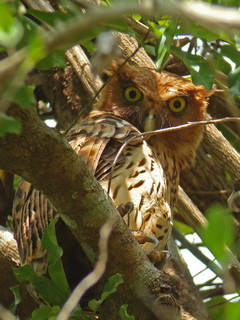
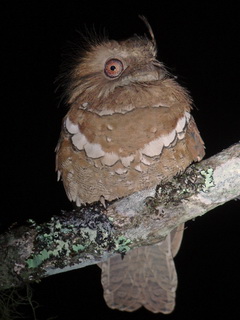
A visit to La Mesa Ecopark in Manila these days is regarded as essential as it’s got those easy Ashy Thrushes so this is where we went first thing in the morning at the start of our tour. It took a while and a Mangrove Blue Flycatcher before we finally connected with our Ashy Thrush on the way out. It performed beautifully though and we’re certainly happy with the photo results. La Mesa isn’t a big city park but very ‘green’ rather than manicured to perfection and it would make for a pleasant spot if it wasn’t for the noisy crowds and it’s location in the middle of an ugly and highly polluted city. I believe I like my birding in more natural, more interesting and wilder places and I guess despite all the recent popularity of the park amongst birders I may personally feel pity for those city dwellers that have to call the place their local patch. Ashy Thrush in the bag, off to Candaba marsh and happy to be out of Manila. Let the birds come and let the tour start in earnest… Philippine Duck, Wandering Whistling Duck, both Yellow and Cinnamon Bittern, Eastern Marsh Harrier, White-browed Crake and Philippine Swamphen all kept us going until we realized it had become quite late so we opted for lunch en-route rather than in Subic.
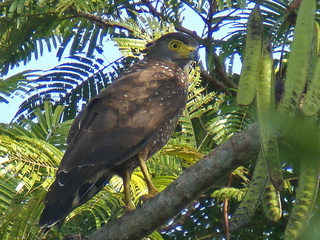
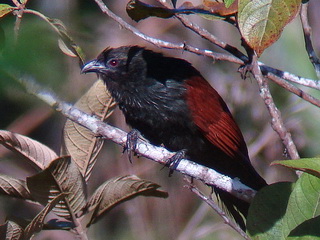
Philippine Serpent Eagle, SubicPhilippine Coucal, Kitanglad
With the afternoon still hot and dry we had time for a little rest in our homey hotel by the beach before venturing out to catch the late afternoon activity in the forests of Subic Bay. We did well and in a good hour time notched up Green Racquet-tail (at its last stronghold), Guaiabero, Coleto, Philippine Woodpecker, Brown-breasted Kingfisher, Elegant Tit and Balicassiao, a fine set of endemics to start with indeed. Spotted Wood Kingfisher had been calling at dusk but the daylight was going fast and so we started the next day in the same spot for the same Kingfisher. It proved fruitful and everyone had good views of the Spotted Kingfisher within a couple minutes. Walking on to see what else we could find along the same stretch of road was a good tactic as we soon found a Luzon Hawk Eagle perched. Shy as they are, they don’t do this very often, showing so well, and most sightings are on the wing indeed. We were lucky. The rest of the morning went on with plenty other Subic specialities; Sooty Woodpecker, Blackish Cuckooshrike, Rufous Coucal, Red-crested Malkoha… until it was time for lunch and some rest during the hot hours of the day. Hotel on the beach, swimming pool, wifi… time used well while the forest is hot and bird activity near to zero. In the afternoon we first stopped at the fruit bat colonies and then spent the rest of the day in the Nabusan area. Our White-browed Shama performed brilliant on the stake-out and was the highlight enjoyed by all through the scope. Nabusan is good for White-bellied Woodpecker, Blue-naped Parrot and Luzon Hornbill as well and I liked the Osprey that came overhead. At dusk we were successful with Philippine Nightjar but both calling Philippine Hawk Owl and Chocolate Boobook remained out of sight.
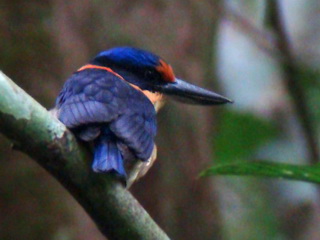
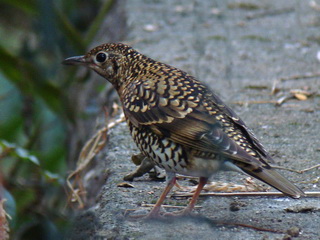
Rufous-lored Kingfisher, BoholSurprise sighting at Los Banos, a Scaly Thrush
The bunkers at Hill 394 are in use again as storage for explosives and of course the area is highly secured nowadays. Nevertheless we had managed permits for our visit although we found the guards being very nervous and picky about safety and so on. Future entrance to the site may be short-lived and this would be a pity as it’s the only real chance on White-lored Oriole which certainly required some effort to find on this trip but we managed good looks in the end. Surprisingly we saw the only Philippine Falconets of the tour at hill 394, lucky we got in with our day-passes. Enroute to Makiling we detoured via Angono for the daytime viewing of Philippine Eagle Owl. Great to know they are still breeding at the site and good to know we kept safe as we watched a King Cobra on the walk in. A Scale-feathered Malkoha was a nice surprise as well at an unusual site with little proper forest around. Ironically, we didn’t see any at the prime site for this species, Makiling, for the first time on our tours as I can remember. Lucky again that we had picked it up at Angono.
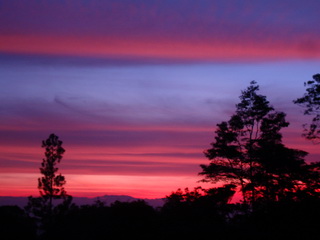
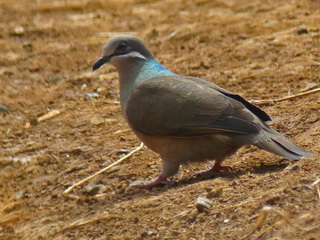
Our sunset at Del Monte lodge on Kitanglad.White-eared Dove
We started early and successful the next morning at Makiling with Philippine Hawk Owl seen before dawn. The track up Makiling appeared a bit quiet with slow birding for the morning but who does mind if the first bird off is a Philippine Trogon? Flaming Sunbird is another speciality for the site and we saw 2 pairs. Also Handsome Sunbird, Purple-throated Sunbird and Grey-throated Sunbird showed and we did equally well on the Flowerpeckers with Striped, Buzzing and Red-striped all seen. Yellowish White-eye and Sulphur-billed Nuthatch are a couple other endemics we found before our visit to the Botanical Garden where we could not find Indigo-banded Kingfisher, presumably due to the low water level in the river. By the bridge on the campus we found Yellow-wattled Bulbul and a surprise Scaly Thrush, a scarce winterer and my first sighting in the Philippines. The dairy farm area was good for a pair of the endemic Spotted Buttonquail, Philippine and Lesser Coucal and Barred Rail.
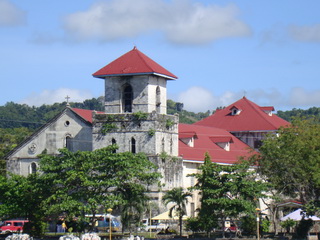
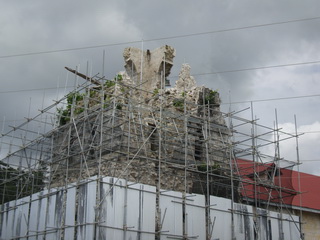
A little history interest on our tours. Bohol's oldest church before (photo Phil. tour 2012)and after the October 2013 earthquake.
On to Bohol where evidence of the earthquake from Oct. 2013 was limited to the destruction of the historic churches and a couple bridges while any of the modern buildings didn’t suffer any major damage. From the best hotel in Tagbiliran we first walked to the town square to watch the spectacle Asian Glossy Starlings come to roost. For our guests this also is an opportunity to get exposed to the sensory overload a messy Filipino town has on offer. To walk the streets for a couple minutes and sense the culture on the chaotic streets is a good experience, at least if it doesn’t last for longer than a moment that is. Next day was peace and quiet again on the forest trails of Rajah Sikatuna National Park. Samar Hornbill is listed as Least Concern by Birdlife, however forest destruction by typhoon Yolanda last November 2013 has left populations on Leyte, Biliran and Samar decimated. It was good to connect with the species on Bohol and I’m quite happy with the photo opportunity the birds offered on this occasion. The trails and dense forest aren’t easy birding on Bohol but with some good effort we succeeded finding most of the targets. And they are quite a few at a place as excellent as Rajah Sikatuna; Rufous-lored Kingfisher, Black-faced Coucal, Yellow-breasted Tailorbird, Philippine Fairy Bluebird (now very often missed at Picop!), Streaked Ground Babbler, Silvery Kingfisher, Buff-spotted –rufopunctatus- Flameback, Yellow-breasted Fruit Dove, Philippine Oriole, Philippine Trogon, Philippine Leaf Warbler, Blue Fantail, Rufous-fronted Tailorbird, Metallic-winged Sunbird and Black-crowned Babbler. Philippine Colugo and the Tarsiers were on appointment and we enjoyed lunch at both the Chocolate Hills with Pygmy Swiftlets and at the Butterfly garden with Purple-throated Sunbirds.
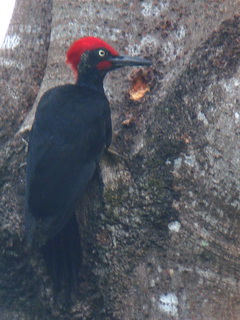
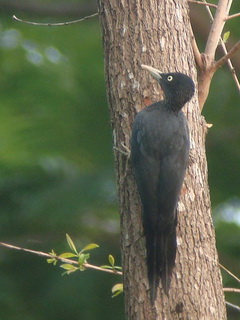
Subic is the perfect place to watch Woodpeckers.
Here a male White-bellied and the endemic Sooty Woodpecker on show.
In good tradition we proved again that a daytrip on Cebu can both be pleasant and rewarding. Avoiding the steep and muddy trails at Tabunan we did visit Alcoy forest which provided with easy roadside birding. The endangered single island endemic Black Shama was seen well within minutes of arrival. Also White-vented Whistler and Black-chinned Fruit Dove showed well while a Visayan Drongo was rather brief but unmistakable by its white belly. Mangrove Blue Flycatcher in hill forest at 700m above sea level always is a treat and “Philippine Blue Flycatcher” I noticed has recently appeared in some reports for the first time. Interestingly this will clash with Sulawesi Blue Flycatcher as they are exactly the same ‘mountain’ Mangrove Blue Flycatchers split off in the past while Philippines wasn’t on the minds. But never mind, the Handsome Sunbird showed again in exact the same tree as the year before and the year before that…and I knew it would sit quite high so I took the opportunity to photograph our group instead! We then watched some shorebirds on the way back to Cebu city while the lunch stop with German snitzels and Cordon Blue have become another tradition on this most enjoyable day trip.
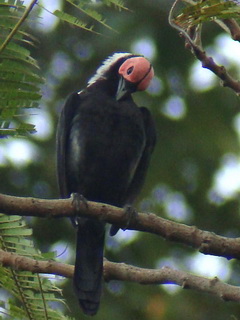
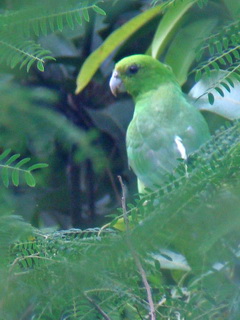
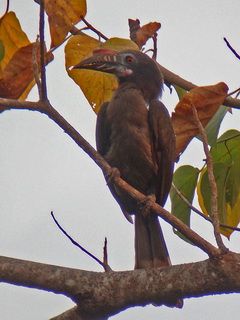
Coleto is one of my favourite endemics, Green Racquet-tail has it's last stronghold in Subic Bay while Luzon Hornbill is still common at Subic.
Kitanglad started excellent even before our arrival proper as on the walk up we found 3 Chestnut-cheeked Starlings which are a first for me in the Philippines, but no wonder as there had been an influx of them reported. After having settled in Del Monte lodge we went out for a first short walk… I think we managed to walk no more than a hundred meter in the first hour as we encountered a huge flock just up from the lodge so we could knock off plenty Kitanglad targets straight away; Black-and-Cinnamon Fantail, Rufous-headed Tailorbird, Stripe-breasted Rhabdornis and so on but we also found a surprise Bicolored Flowerpecker which at 1300m altitude is quite high and unusual. At dusk the Bukidnon Woodcocks gave a show as well as Philippine Nightjar. Then we finished the day in style with Philippine Frogmouth and of course a tasty dinner and some beers as always. Red-eared Parrotfinch was the first call for the next day and this was actually the first time I’ve seen 6 birds together. Ironically these beauties like to feed on seeds of Tithonia diversifolia, a plant introduced from Mexico and used to help fertilize farmland. This Mexican Sunflower – Red-eared Parrotfinch connection is a very rare example where birds in Philippines benefit from human intervention which of course in this case only happens as a pure coincidence. We then walked on further picking up other birds en-route to the Eagle viewpoint where we eventually got 2 sightings of the Philippine Eagle. First distant and half an hour later much closer on the wing after which it went to perch on the hillside although it then looked more like a little white dot rather than a fully grown Eagle due to the distance. On our last full Kitanglad day we succeeded finding Apo Sunbird, McGregor’s Cuckooshrike, Apo Mynas, Black-masked White-eye and White-cheeked Bullfinch on the high trail and we had a very close encounter with the Philippine Eagle as we flushed it from a tree above the trail. Excellent! After some final birding on our last day it was time to walk down to meet our van and driver so 4 of us could travel back to Manila while I took a couple onward to Davao and Mindoro to start celebrate with our 5th anniversary trip.
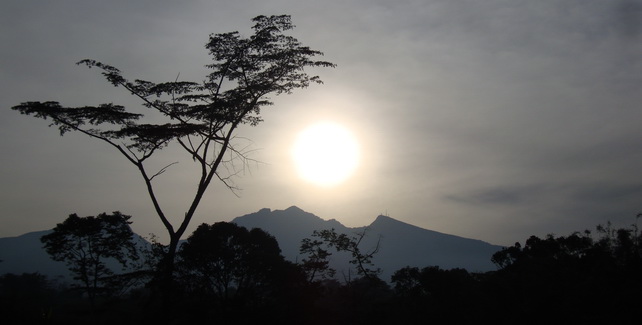
Mount Kitanglad
Home / Other B2A reports / Philippine tour page / Tour calendar
We could have written this last year and the year before and so on. In general Dec. and Jan. can still be extremely wet in the central and southern part of the Philippines while Luzon, perhaps Palawan, does enjoy dry weather from earlier on in what is usually regarded as the birding tour season. In other words, one need to find himself very lucky with the weather for a chance on a pleasant trip throughout if going in Dec.- Jan., while later on not only the weather improves in the southern part, also the height of the breeding season commences which of course may result in quite a few species becoming easier to find.
I mean it can rain at any time of the year anywhere in the Philippines, just looking at an enjoyable tour covering the main islands I would say "the season" starts in February. March up to at least mid-May are excellent as well as far as the birding and weather goes in Philippines although not as great to escape the winter in Europe or North America… these may hardly be my own words, I may just be adding to what the late Tim Fisher used to say about the Philippine birding season...

